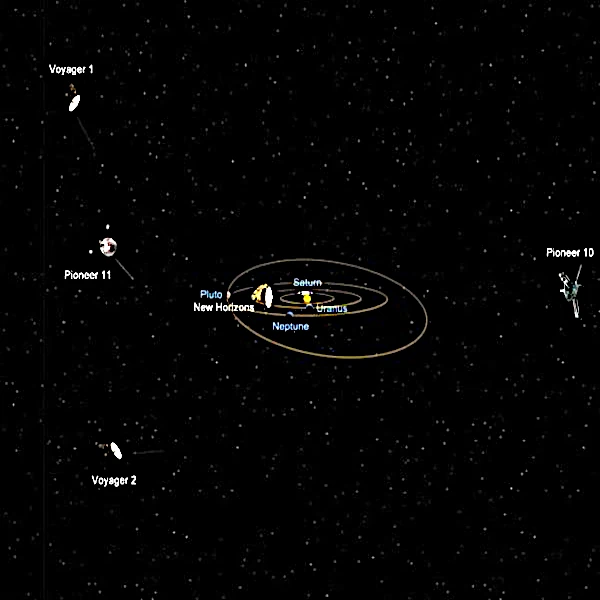
The Voyager 1 and Voyager 2 probes, launched in 1977 by NASA, represent a feat of space engineering and a physical achievement. Their initial goal was the exploration of the giant planets of the outer solar system — Jupiter, Saturn, Uranus, and Neptune — as well as the study of planetary environments, magnetic fields, and energetic particles at these distances. Beyond their planetary mission, they are now on a trajectory that takes them to the edge of the solar system and into interstellar space, providing invaluable data on the structure of the heliosphere and the interstellar medium.
Each probe is equipped with scientific instruments for measuring charged particles (plasma), magnetic fields, radio waves, as well as images and spectra in different wavelengths. Physically, their trajectory uses gravitational assists, a phenomenon of non-Newtonian orbital mechanics in the multi-body framework, to increase their speed out of the solar gravitational well. For example, Voyager 2 used these maneuvers to pass near Uranus and Neptune, while Voyager 1, with a different trajectory, was able to accelerate toward the galactic plane.
The probes have crossed crucial physical boundaries. The first termination shock corresponds to the zone where the supersonic solar wind slows abruptly under the effect of the pressure exerted by the interstellar medium. Voyager 1 crossed it in 2004, Voyager 2 in 2007. Further out, the probe reached the heliopause, the boundary where the dynamic pressure of the solar wind is balanced by the interstellar medium. These zones are characterized by complex variations in plasma densities, magnetic fields, and energetic particles detected by onboard instruments, providing a unique natural laboratory for plasma physics under extreme conditions.
The measurements made by Voyager have characterized the local electron density, plasma temperature, and magnetic turbulence in these regions. Voyager 1 data, for example, revealed a stronger-than-expected interstellar magnetic field, implying a more dynamic interaction between the solar wind and the interstellar medium. The probes also allow the study of galactic cosmic rays, whose modulation strongly depends on the boundaries of the heliosphere, a key parameter for understanding the spatial environments influencing the planets.
Communicating with Voyager 1 and Voyager 2 presents a major technical and physical challenge due to the extreme distances these probes have reached. In 2025, Voyager 1 is located more than 23 billion kilometers from Earth, and Voyager 2 more than 19 billion kilometers, resulting in radio signal latency times of around 20 to 22 hours round trip. This distance creates several fundamental constraints.
The radio signal emitted by the probes is extremely weak due to the intensity loss that follows the inverse square law of distance. With the initial transmission power being limited (about 20 watts), ground antennas, such as NASA's Deep Space Network (DSN), must use very large parabolic antenna arrays and advanced signal processing techniques, including correlation and very sensitive demodulation, to extract useful information from a very high background noise.
The stability of the carrier frequency is crucial: the probe uses quartz oscillators which, despite their precision, experience drift over several decades. To compensate for these variations, ground stations synchronize their clocks with ultra-precise atomic standards, and communication uses error correction codes (such as convolutional coding) to minimize information loss caused by electromagnetic disturbances and propagation phenomena in the interplanetary medium.
Precise orientation of the probes' high-gain antennas is essential. This orientation must be maintained with angular precision on the order of a few microradians to direct the radio beam towards Earth. This attitude control is ensured by gyroscopes, accelerometers, and star sensors, combined with very low thrust propulsion systems (hydrazine thrusters). Any failure or deviation can result in the loss of the signal.
The electrical energy available to power the communication system decreases over time, as the radioisotope thermoelectric generators (RTGs) see their power decrease due to the decay of plutonium-238. This decline limits transmission power and the duration of use of scientific instruments, making energy management a crucial issue for extending the mission.
Communication with Voyager 1 and 2 involves a sophisticated combination of electromagnetic wave physics, embedded systems engineering, and energy management under extreme conditions, illustrating the current limits of interstellar space exploration.

The image known as the "Pale Blue Dot" is one of the most symbolic photographs taken by the Voyager 1 probe on February 14, 1990. At a distance of about 6 billion kilometers from Earth, Voyager 1 turned its camera toward our planet, capturing a tiny bright spot suspended in the black immensity of interplanetary space.
This image reveals Earth as a tiny bluish speck barely visible in a diffuse beam of sunlight scattered by the Earth's atmosphere and cosmic dust. From a physical point of view, it illustrates the relativity of our landmarks: our planet, the source of all known life, appears almost insignificant compared to the abyssal expanse of the cosmos.
The famous astrophysicist Carl Sagan (1934-1996) was deeply inspired by this photograph to write his book "Pale Blue Dot: A Vision of the Human Future in Space." In this book, he meditates on the fragility and uniqueness of Earth, emphasizing with emotion: "Look again at that dot. That's here. That's home. That's us." This sentence illustrates a major philosophical and scientific awareness: despite all our supposed greatness, our civilization rests on this tiny pebble suspended in cosmic darkness.
From a technical point of view, capturing this image required exceptional coordination between the probe and ground control, particularly by turning the main camera away from its usual orientation to capture Earth behind the Sun, while minimizing the risks associated with glare and the dissipation of the optical signal. This shot represents a feat of space engineering as well as a profound invitation to humility.
Thus, the "Pale Blue Dot" transcends its status as a simple scientific image to become a powerful symbol of space exploration, reminding humans of the need to preserve their unique planet and to consider their future in the immensity of the cosmos with wisdom and responsibility.